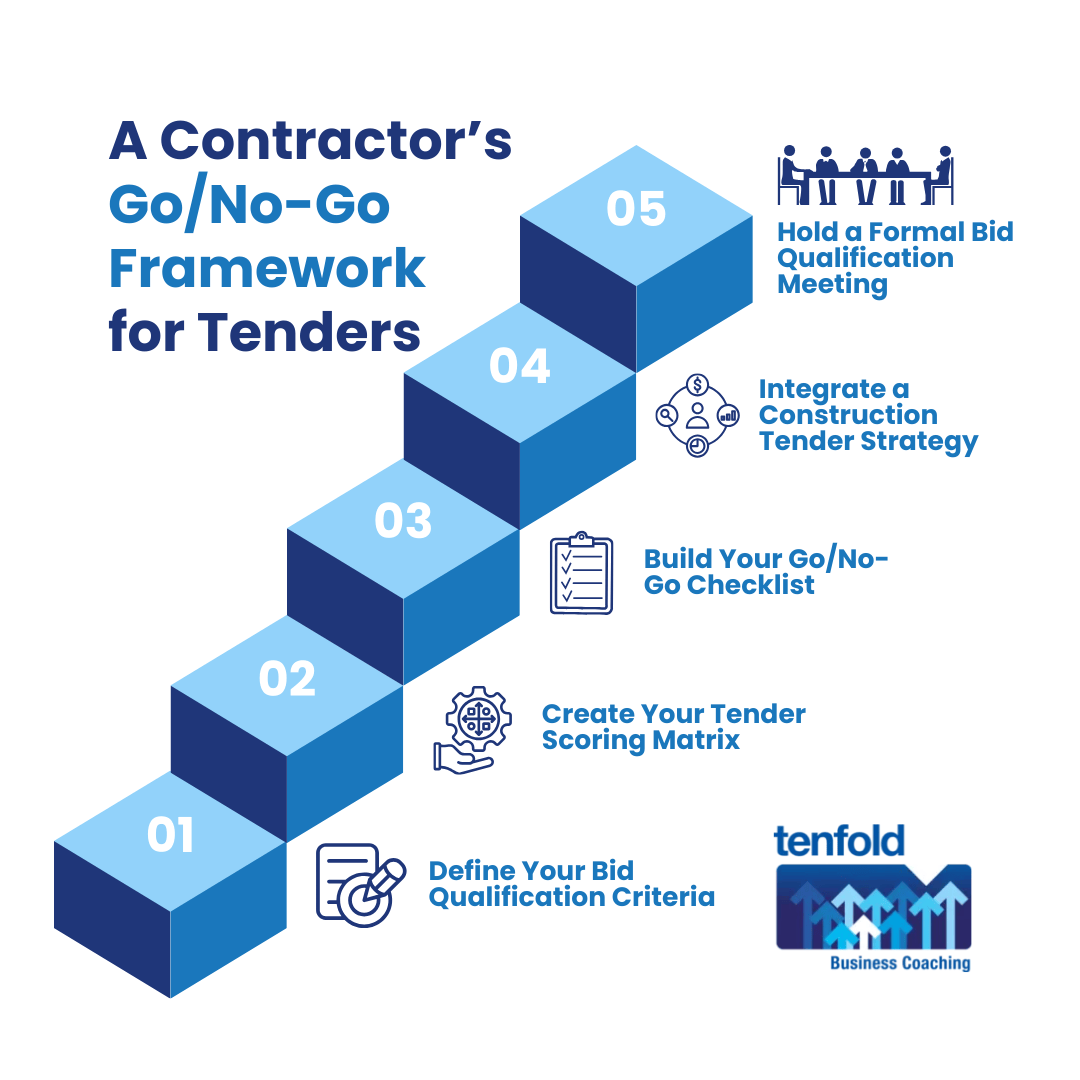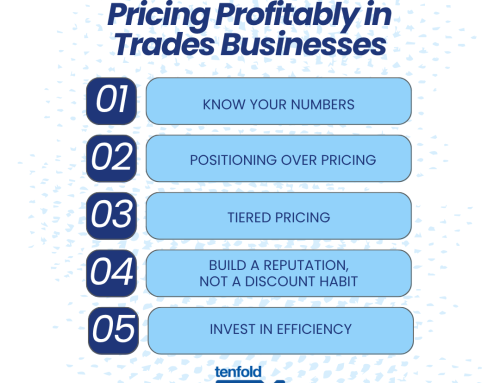Only Bid to Win: A Contractor’s Go/No-Go Framework for Tenders
As a small business coach based in Australia, I understand how tempting it can be for contractors and construction firms to pursue every tender opportunity that comes their way. The desire to expand revenue, enhance your reputation in the industry, and demonstrate your building expertise is strong.
However, chasing after every project without careful consideration can lead to eroded profit margins and a reduced success rate for tenders. In this comprehensive guide, I will introduce you to a proven bid/no-bid framework designed specifically to safeguard your profits and boost your success rate in competitive tenders. You will discover clear decision rules, practical and actionable tools, as well as real-world examples tailored specifically for Australian contractors and builders, helping you make smarter, more strategic bidding decisions that align with your business goals and capacity.
Why a Tender Go/No-Go Framework Matters
Without implementing a formal go-no-go checklist, there is a substantial risk that you could be allocating valuable resources towards low-probability bids. This approach can undermine your overall tender success rate, as you might be wasting time and effort on opportunities that are unlikely to result in a winning outcome. Additionally, it can lead to inconsistent project delivery, which in turn dilutes your brand reputation among clients and industry peers. This inconsistency may cause potential clients to question your reliability and professionalism.
Furthermore, by pursuing bids that are not properly vetted, you may be sacrificing margin in the pursuit of winning at any cost, which is unsustainable in the long run. The lack of a structured bid qualification process can result in a scattergun approach, where resources are spread thin across a multitude of proposals that are unlikely to be profitable or strategic.
On the other hand, by adopting a structured bid qualification process, your organisation can focus its efforts on tenders where there is a genuine chance to deliver value. This approach allows you to differentiate your proposal from competitors, demonstrating your unique strengths and capabilities. It also ensures that your team concentrates on the opportunities that align with your strategic goals, increasing the likelihood of winning profitable tenders.
In the Australian business environment, where competition is fierce and deadlines are tight, having a clear and structured process for bid selection is crucial. It helps in managing resources efficiently, maintaining your reputation for delivering high-quality work, and ensuring sustainable growth by focusing on the bids that truly matter.
Step 1: Define Your Bid Qualification Criteria
Begin by establishing clear and specific thresholds that every potential opportunity must meet before you decide to invest your time and money. These thresholds serve as critical criteria that help you evaluate whether an opportunity warrants your resources, ensuring you focus only on the most promising prospects.
Key categories for bid qualification:
- Project size and budget alignment
- Geographic location and travel feasibility
- Technical scope consistency with your core skills
- Client reputation and payment history
- Strategic value (e.g. entry into new sectors)
Reflective Question
- Which of these criteria has cost you time on past tenders?
Step 2: Create Your Tender Scoring Matrix
Using a tender scoring matrix streamlines the decision-making process by providing objective scores and weights, which help ensure transparent and consistent evaluation of all bids or proposals. This method simplifies complex decision-making, reduces bias, and enhances the overall efficiency of selecting the most suitable candidate or supplier.
| Criteria | Weight (%) | Score (1–5) | Weighted Score |
| Alignment with core services | 25 | 4 | 1.00 |
| Project margin potential | 20 | 3 | 0.60 |
| Client reliability | 15 | 5 | 0.75 |
| Competition intensity | 15 | 2 | 0.30 |
| Strategic growth opportunity | 15 | 4 | 0.60 |
| Resource availability | 10 | 5 | 0.50 |
| Total | 100 | 3.75 |
How to use the tender scoring matrix:
- Assign a score from 1 (poor) to 5 (excellent) for each criterion.
- Multiply each score by its weight.
- Sum the weighted scores.
- Set a threshold (for example, 3.5) for go/no-go decisions.
Reflective Question
- What weightings best reflect your company’s priorities?
Step 3: Build Your Go/No-Go Checklist
A concise go-no-go checklist helps ensure that all critical factors are thoroughly considered before proceeding with an important decision or project. This organised approach allows teams to systematically evaluate each key aspect, minimising risks and enhancing the likelihood of success.
| Checklist Item | Yes/No | Notes |
| Does project budget meet minimum margin threshold? | ☐ | Preferred margin > 15% |
| Do we have relevant references or past examples? | ☐ | Project type and scale match |
| Can we meet the client’s timeline? | ☐ | Allow buffer for delays |
| Are specialist subcontractors available? | ☐ | Confirm their capacity |
| Does the tender align with strategic goals? | ☐ | New market entry or growth |
Checklist best practices:
- Keep the document live in your project management tool
- Review checklist in a weekly pipeline meeting
- Escalate unclear items immediately
Reflective Question
- Which checklist item do you often skip or rush?
Step 4: Integrate a Construction Tender Strategy
A construction tender strategy effectively integrates your scoring matrix and checklist into the daily operations and processes involved in managing and executing construction projects, ensuring a more streamlined and consistent approach.
Key tactics for contractors:
- Early engagement with client contacts to clarify scope
- Workshop sessions to refine technical responses
- Standardised templates for recurring work packages
- Risk register to flag major cost or timeline exposures
- Decision gates at key dates (expression of interest, RFP, final bid)
Reflective Question
- How can you streamline your pre-tender information gathering?
Step 5: Hold a Formal Bid Qualification Meeting
Gather your core team and convene a comprehensive bid/no-bid framework meeting to thoroughly evaluate potential opportunities and determine the most strategic course of action.
Meeting agenda:
- Review scoring matrix results
- Complete go/no-go checklist together
- Discuss resource and cashflow impacts
- Decide to proceed, defer or decline
Use a simple tracker to record the decision:
| Tender Name | Decision | Date | Responsible | Comments |
| Central City Library | Go | 01/08/2025 | John Smith | High margin; niche skill |
| Riverside School Upgrade | No-Go | 02/08/2025 | Jane Doe | Timeline too tight |
Reflective Question
- Who on your team needs to be in every bid/no-bid meeting?
Tracking Tender Hit Rate and Margin
Maintaining a detailed tender hit rate log not only records the success rates of various bids but also reveals important patterns and trends over time. This process subsequently guides organisations in identifying areas for improvement and refining their strategies to enhance overall success. By regularly updating and analysing this log, teams can make informed decisions that contribute to continuous improvement and greater efficiency in their bidding efforts.
| Month | Tenders Submitted | Wins | Hit Rate (%) | Average Margin (%) |
| January | 10 | 4 | 40 | 18 |
| February | 8 | 3 | 38 | 17 |
| March | 12 | 6 | 50 | 20 |
| April | 9 | 5 | 56 | 19 |
Best practices for tracking:
- Update after each tender outcome
- Analyse quarter by quarter for trends
- Adjust your bid qualification criteria based on results
Reflective Question
- What hit rate target will push your growth without sacrificing margin?
Continuous Improvement in Your Bid/No-Bid Framework
Refine your business framework on a quarterly basis by thoroughly reviewing tenders that were not successful to identify areas where your scores were weak or could be improved. This process involves updating the weightings in your scoring matrix to better reflect current priorities and adjusting minimum margin thresholds to ensure your bids remain competitive and profitable. Additionally, it is important to ensure that your team is regularly trained and updated on emerging client needs, market trends, and industry developments. This ongoing education will help your team stay ahead of the competition and respond effectively to the evolving landscape of the Australian market.
Take Charge of Your Tender Process
You now have a clear, practical tender go/no-go framework that will safeguard your margins, sharpen your bid/no-bid decisions and boost your tender hit rate. By defining qualification criteria, scoring each opportunity objectively, running a concise go/no-go checklist and tracking your outcomes, you’ll spend time only on contracts you can win profitably. If you’d like expert support to tailor this framework to your construction business, get in touch with us at Tenfold Business Coaching. As your trusted small business coach, I’ll work alongside you to refine your decision rules, optimise your processes and set you up for consistent growth.
FAQs on Tender Go/No-Go and Construction Tender Strategy
What is a bid qualification process and why is it vital?
A bid qualification process is a comprehensive and systematic assessment that you apply to each tender opportunity before deciding whether to invest valuable resources and time. This process helps ensure that only the most promising and suitable tenders are pursued, thereby protecting your profit margins, minimising wasted effort on unlikely prospects, and ultimately increasing your overall success rate in winning tenders.
How do I choose the right criteria for my tender scoring matrix?
Select criteria that accurately reflect your strategic goals, operational capabilities, and financial targets to ensure a comprehensive evaluation. These criteria might include factors such as margin potential, client reliability, resource fit, scalability, market demand, and competitive advantage. Assign weights to each criterion that mirror your organisation’s priorities, emphasising the most critical aspects to align with your overall strategy. This approach helps in making informed, balanced decisions that drive your business forward.
Can I customise this go/no-go checklist for different project types?
Yes, you should use the core template as your foundational document. From there, you can adjust specific items or thresholds to better suit specialised projects such as fit-outs, civil works, or renovations. It’s also important to keep a version history of all changes made over time, so you can track the evolution of your documentation and ensure consistency and accountability throughout the project lifecycle.
What tools can help me automate the bid/no-bid framework?
Project management software options such as Asana, Trello, and similar platforms, along with Customer Relationship Management (CRM) systems and even simple spreadsheets, can all serve as effective tools to host and organise your scoring matrix, checklists, and tracking systems. The essential factor in choosing the right tool is ensuring that your team has clear visibility and easy access to these resources at all times, which helps facilitate collaboration, improve transparency, and streamline workflow processes across the project.
How often should I review and update my framework?
Aim to conduct a comprehensive review at least once every quarter. To ensure consistency and relevance, align this review with your broader business coaching services or integrate it into your scheduled board meetings. During these reviews, analyse trends in your tender hit rate and profit margins carefully, as these insights are critical in guiding strategic updates and improvements to your processes.






